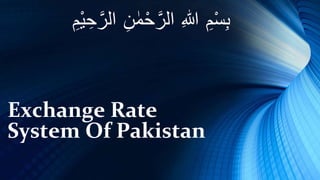Exhange rate (1)
- 1. Exchange Rate System Of Pakistan ŲŲâŦŲ âŽŲâŦØģâŽŲâŦØĻâŽŲŲâŦŲŲاâŽŲŲâŦŲ⎠Ų°âŦŲ âŽŲâŦØâŽŲŲâŦاŲØąâŽŲŲâŦŲŲ âŽâŦŲ⎠ŲâŦØâŽŲŲâŦاŲØąâŽ
- 2. Group Members: 1. Amna Sarfraz BAFM-19-04 2. Zainab Qureshi BAFM-19-14 3. Rida Fatima BAFM-19-19 4. Asmat Tahira BAFM-19-37 5. Maham Afzzal BAFM-19-40 6. Areej Fatima BAFM-19-68
- 4. INTRODUCTION Exchange Rate Regime: An exchange rate regime is how a nation manages its currency in foreign exchange market and is closely related to the country's monetary policy. Types of Exchange Regimes: à Fixed Exchange à Floating Exchange à Pegged Float Exchange
- 5. Currency system-maintain a currency value that is constant against a specific currency or good. central bank maintain reserves of foreign currencies and gold. Country's government decides the worth of its currency : Þ Fixed weight of an asset Þ Another currency. Most famous fixed rate is the gold standard. 1. Fixed Exchange:
- 6. Best possible exchange rate regime- automatically adjust to economic circumstances. Dampens the impact of shocks and foreign business cycles. Reduces the possibility of having a balance of payment crisis.. Floating currency: Currency used in floating exchange rate system. Example: Dollar System in which currencyâs value is allowed to fluctuate according to the foreign exchange market 2. Floating Exchange:
- 7. Currencies are pegged to some band or value, which is either fixed or periodically adjusted Hybrid of fixed and floating regimes There are three types of pegged float exchange listed below. â Crawling bands â Crawling pegs â Pegged with horizontal bands 3. Pegged Float Exchange:
- 8. Exchange Rate: Value of a nation's currency in terms of the currency of another nation or economic zone. Pakistan Exchange Rate System: Pakistan's policy is a âmarket based exchange rate systemâ that follows supply and demand, but that will not be left completely to the market
- 10. Bank lending-80% of the corporate debt Firms guard currency risk through financial instrument Composition of firms' balance sheet including assets Nature of firm: Export or Import oriented SECTORS INVOLVED IN EXCHANGE RATE
- 14. Current Account Deficit â Indicates Imports are greater than exports â Not always detrimental to a nation's economy-external debt may be used to finance lucrative investments. â Emerging countries often run surpluses whereas developed countries tend to run deficit.
- 15. Methods of Achieving Equilibrium: âBalance Of Payment âAsset Market Model
- 20. DETERMINANTS Gross Domestic Product (GDP) Terms of Trade Trade openness Interest Rate Money Supply DETERMINANTS OF EXCHANGE RATE Determinants- the important factors to dictate the changes in the pattern of official exchange rate of Pakistan.
- 21. GDP-the basic size of the country's economy. It is the representation of the dollar value of goods and services that have been produced within that country The terms of trade is related to current accounts and the balance of payments. and is directly proportional to the currency value of a country. Trade Openness is the sum of imports and exports normalized by GDP Higher interest rates tend to attract foreign investment, which is likely to increase the demand for a country's currency. 2. Effect of Determinants: Money supply and exchange rate are inversely proportional to each other
- 22. Domestic industry Marginal cost channel Markup channel Firmâs Market share Impact Of Exchange rate on Domestic Industry: An exchange rate shock can affect domestic prices through two distinct channels. âĒ The first is a direct effect through the marginal cost channel, as the exchange rate alters the price of imported inputs. âĒ The second, more indirect effect, is through the markup channel.
- 26. IMPACT OF CURRENCY DEVALUATION Positive Impacts: ⊠May be good for economy ⊠Economic Growth ⊠Stimulation of merchandise exports ⊠Discouraging merchandise imports ⊠Improving trade ⊠Increase revenue collection and savings ⊠Stop illegal foreign exchange
- 27. Negative Impacts: ⊠Increase liability and foreign loans repayment. ⊠Increase the trade gap. ⊠Stop ongoing projects due to rising costs ⊠Raise industrial costs ⊠Reduce the intensity of capacity utilization.
- 28. MONETARY MEASURES: DEVALUATION REVALUATION Declining the value of our country's currency that reduces the price of export and increases the price of import which therefore saves the domestic industry. Improve the value of our country's currency that increases the price of export goods and decreases the price of imports
- 30. FLUCTUATIONS IN EXCHANGE RATE Constant Fluctuation- Exchange rate freely float against one another. Higher demand for a particular currency-Value of currency will increase
- 31. Increased Demand of Currency: âĒ Increased Transaction âĒ Increased speculative demand Speculative Demand: âĒ Higher the Interest Rate âĒ Higher the currency demand Transaction Demand: âĒ Level of Business âĒ Employment Levels CURRENCY DEMAND
- 32. Effect Of Currency Fluctuation On Economy: Trade: Weak currency makes the imports more expensive while stimulating the exports by making them cheaper for the overseas customers. Capital Flows: Stable currency to attract capital from foreign investors. Inflation: Devalued currency results in "imported" inflation.
- 34. THANKYOU

































